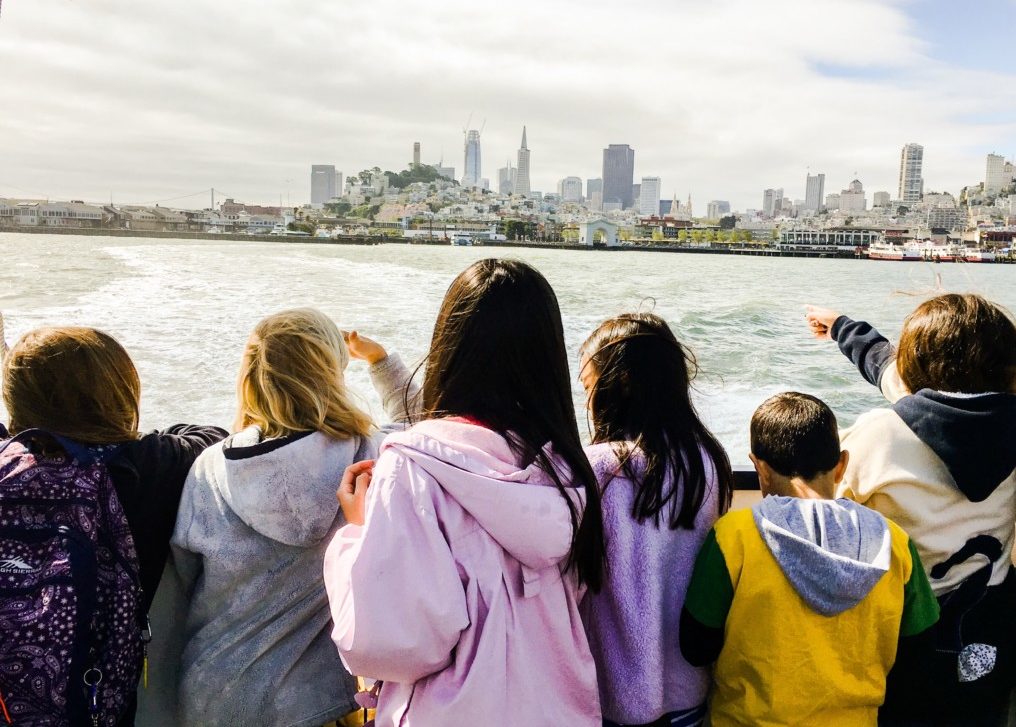
Over the course of the past seven-going-on-eight years that one or both of my two daughters have been students at a public K-5 in San Francisco, I’ve chaperoned my fair share of school field trips. Being a chaperone is a tough job, but somebody’s got to do it or field trips simply couldn’t happen. And, moans and groans aside, chaperoning can actually be a fun way to support your child’s education while visiting some pretty cool places – this is San Francisco, after all! Here are the ABC’s of chaperoning school field trips in San Francisco, a collection of tips, observations, and insights, as well as a few specific field trip recommendations, based on my own personal experiences as a chaperone.
Aspirin: If you’re not used to being around large groups of kids for long periods of time, and particularly if you’ll be traveling by school bus (not quite the ninth circle of hell, but close), bring along some aspirin, Advil or your pain-killer of choice.
Bus: The school bus is a blessing (you could be on MUNI, after all) and a curse (see A is for Aspirin). Take my advice, and unless the teacher really needs you somewhere else, sit in the front and don’t look back!
Counting: Counting is a big part of being a chaperone. You will count and recount at every critical juncture in the field trip to make sure you haven’t lost anyone. Not losing anyone, of course, is the main goal as a chaperone. Anything else is gravy.
Driving: For some field trips, where public transportation is not an option and when school buses or funding for them aren’t available (often the case for public schools), parent chaperones may be asked to drive kids in their own cars. So, make sure your car registration and insurance are up-to-date if your chaperoning duties will include driving.
Exhaustion: Know that you will be exhausted after a day of chaperoning and plan accordingly. Think take-out for dinner and a relaxing bubble bath post-field trip.
Focus: Keep your focus on the kids in your group and don’t be that parent who spends the field trip on their phone. We’re all busy, but if you commit to chaperoning a field trip, be a chaperone and put your phone away (except, of course, to take photos!)
Gold: Panning for gold is an especially memorable part of visiting the Oakland Museum of California, a field trip many San Francisco students take in fourth grade when they focus on California history. As a chaperone, you’ll help the kids put the tiny flakes of “gold” that they find into small bags to bring home.
Help: Remember that you are there to help the teacher and keep the kids safe and under control, not to socialize with your mom and dad friends or to have one-on-one time with your own kid.
Immigration Station: While managing a group of kids on a ferry presents certain unique challenges, the field trip to the Angel Island Immigration Station, the Ellis Island of the West, is not to be missed if you have the chance to chaperone this one (my kids went in third grade).
Jackets: Bonus points if you are able to keep track of not only the kids in your group, but their jackets, lunch bags and other personal items.
Kids: Chaperoning field trips is a great way to get to know the kids in your child’s class and to see how your child interacts on a social level. Plus, kids can be pretty entertaining once you get them talking.
Learning: Field trips are usually tied into what your child is learning in the classroom. Check in with your child’s teacher in advance to find out how you can help make the visit more meaningful from a learning standpoint.
Memories: Making memories is another important reason to chaperone. When your kid has moved on to middle school and beyond and opportunities to participate in their educational experience become rare to nonexistent, you will treasure the memories of the times you spent together during these sweet K-5 years.
Numbers: Make sure you have the teacher’s cell phone number and the cell phone numbers of one or two other parent chaperones before leaving for the field trip in case you get lost or otherwise separated from the group. You may laugh now, but believe me, it happens.
Outfit: Dress in clothes (and shoes) that you can move, and even run in, and save the cute outfit for another day.
Photos: Take and share lots of photos so parents who weren’t able to come along can see what their kids were up to on the field trip.
Quiet: Learn the techniques and catch phrases your kid’s teacher employs to quiet down the class and use them when needed. Whether it’s the “Quiet Coyote” signal, “Announcements!” or “Bump, bump, bump, bump, bump . . .” call and response, you will find that the kids respond best to the form of communication they are used to.
Rules: Know and enforce the teacher’s rules as well as the rules of the field trip venue to avoid the embarrassment of being reprimanded by a docent and to ensure that your kids’ school will be allowed back for future field trips.
Symphony: The San Francisco Symphony generously provides free music education including a private, age-appropriate concert at Davies Symphony Hall for public school kids in grades 1-5 through its fabulous Adventures in Music (“AIM”) program. The field trip to the Symphony is a wonderful and unique experience that I highly recommend to all San Francisco public school parents.
Teacher: If you aren’t already in complete awe of what teachers do for your kids, chaperoning will give you a deeper appreciation of what the job entails. Seriously, how do they do it day in and day out!?
Urban Realities: In your travels throughout the city, you are bound to encounter the sad and disturbing realities of urban life, particularly in the Civic Center area, where a number of field trip destinations, like the Symphony and Asian Art Museum, are located. Stay alert, and be ready for questions from the kids about things they may see or hear as they pass through these areas.
Victorian Architecture: Another favorite San Francisco field trip of mine is the docent-led tour of the Haas-Lilienthal House, a classic San Francisco Victorian that survived the 1906 earthquake. Kids learn about Victorian architecture and history as well as the family who lived in this particular home. My daughters went here in third grade.
Wonder: Seeing the wonder in kids’ faces as they encounter new places and things is one of the greatest rewards of chaperoning. Enjoy it while it lasts!
Extra Food: Consider bringing along an extra sandwich or snack for the one or two students who will inevitably show up without a bag lunch on the day of the field trip.
Your Name: Tell the kids in your group what they should call you, whether you want to go by your first name or something more formal. Otherwise, you are destined to become [insert your child’s name]’s Mom or Dad.
ZZZZZZZs: Get lots of sleep the night before the trip! Chaperoning field trips will suck every last ounce of energy out of you, so it’s important to start the day as well rested as possible.


















